Democratizing design, empowering millions to become their own graphic artists, and the tool that started it all – Canva. While the world was tangled in the intricate skeins of Adobe, Corel, and other complex design software, Canva emerged as a user-friendly solution to make graphic designing easier for everyone. Today, it has grown into the world’s largest female-founded and woman-led startup. But this success was not achieved overnight. It was years of strategic decision-making and a visionary approach to marketing that helped build this brand. Let’s put Canva marketing strategy into perspective.
Join us in this content marketing case study to unravel the key elements of Canva digital marketing strategy, which helped them acquire over 125 million monthly active users across 190 countries. In the upcoming sections, we’ll also offer insights and lessons that might just inspire your own content marketing strategy.
TL;DR Here’s a quick video summarizing this content marketing case study on Canva
Role of content marketing at Canva
- Making freemium work
- Canva Learn and Design School
- Canva’s content SEO strategy
- Canva on social media
- Canva for Teams case studies
- Canva Creators and Affiliate Program
What we learned from Canva marketing strategy

About Canva
Canva, the online tool for graphic design, was created to help people who didn’t have the necessary graphic design skills or resources to produce impressive visuals and graphics. It offers easy-to-use tools and a straightforward interface with a wide selection of templates, elements, free photos, fonts, and more. Users can design anything they imagine, from logos and brochures to social media posts, and save their designs in different formats and sizes.
The idea takes root
The idea for Canva was born when Melanie Perkins, a communications and commerce student in Western Australia, began teaching the basics of computer design to her peers for some extra income. It was during this time that she realized how complex and cumbersome graphic designing could be for a novice. The process involved several complicated software applications, which came with steep learning curves. Recognizing the need for simpler alternatives, she started her journey of making graphic design easier and accessible to everyone. Perkins first tackled the task of creating professional-grade yearbooks. In 2007, she partnered with Cliff Obrecht to launch a startup called Fusion Books, an online design system for yearbooks, which quickly became a huge success.
Canva’s launch in 2013
High on the success of Fusion Books, Melanie Perkins wanted to expand the business and make design universally accessible. She took her idea to Silicon Valley and launched Canva in 2013, with funding of $3 million. Ex-Google executive Cameron Adams joined her as a co-founder soon after.
The initial version of Canva showed that a basic, user-friendly design platform could be effective. Built on the foundation of Fusion Yearbooks, Canva quickly evolved into a full-fledged graphic design tool, challenging traditional, expensive design tools like Photoshop and Adobe.
This Canva pitch deck shows how Perkins identified the gap in the market and pitched her product as the ultimate solution.
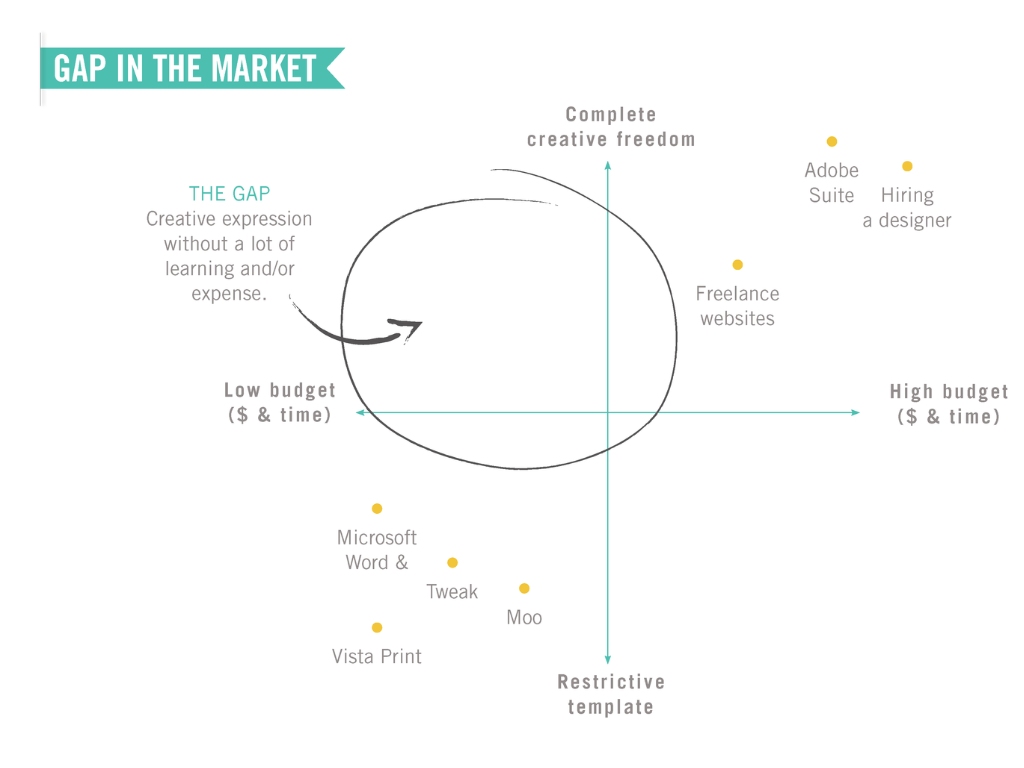
Canva Pitch Deck – Gap in the market (Source)

Canva Pitch Deck – Canva as the ultimate solution for every design need (Source)
Today, Canva stands as a testament to Melanie Perkins’ vision of democratizing design. The company is currently valued at $39 billion and constantly growing and expanding its user base.
So, what led to Canva’s rapid growth? Of course, its unique product and business model were significant contributors, as there was nothing like it during that time. But Canva’s simple, yet genius approach to marketing also played a huge role in its success.
Role of content marketing at Canva
Canva’s marketing strategy is based on the ‘jobs to be done’ framework. They’ve understood that their customers are seeking to accomplish specific creative tasks with the product—similar to how families exploring private schools in California seek tailored solutions to meet individual learning needs.
The best way to get customers on board was to show them exactly how they could do that in the simplest way possible. This is evident from Canva’s homepage, which has not changed much over the years.
It starts with a simple question, “What will you design today?”
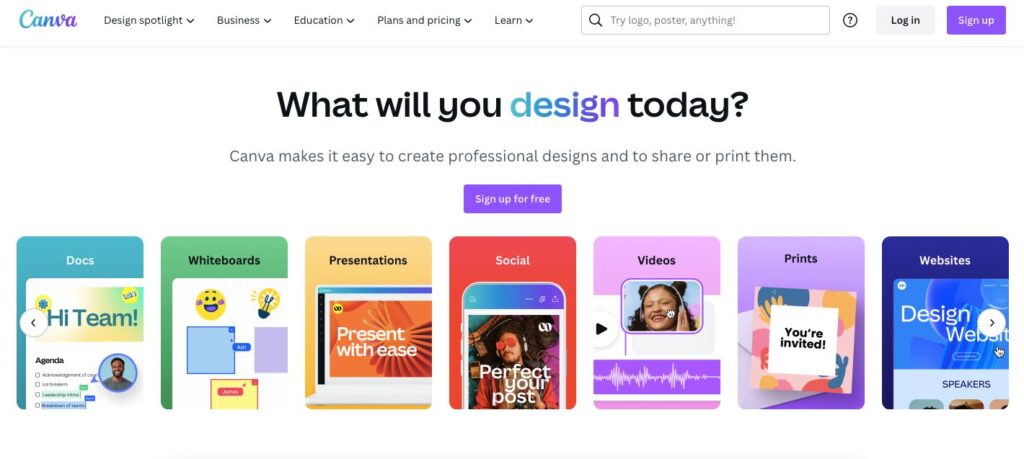
Canva Homepage
The homepage is simple and straightforward, highlighting the product to the visitors as soon as they land on the page. It educates and draws them in to explore further, relying on images, graphics, and minimalistic use of text to communicate.
For Canva, it’s all about simplicity. And this principle carries through in all its marketing strategies. The brand leverages several content marketing channels to encourage product adoption and increase brand reach –
- Blog
- SEO
- Social Media
- Video
- Paid Ads
- Affiliate Marketing
Canva marketing strategy
Canva has not only transformed the way we approach design, but has also set a gold standard for strategic content marketing. In this section, we’ll dissect the strategies and tactics that have positioned Canva as one of the leading SaaS companies today. Let’s start right from the top.
1. Making freemium work
Free features are a powerful marketing tool for SaaS businesses to grow and attract users without having to spend a lot of money on expensive advertisements. And Canva is probably the best example of a freemium marketing model that works.
Canva’s freemium strategy is a blend of both premium and free offerings. It gives users access to the basic features at no cost and offers some of its advanced features as part of the paid subscription. The free offerings are by no means mediocre. Users can still access most of its templates, elements, and features, and create beautiful designs. In fact, the free plan also comes with access to newly added AI-powered design features like Magic Design, Magic Edit, and Magic Write.
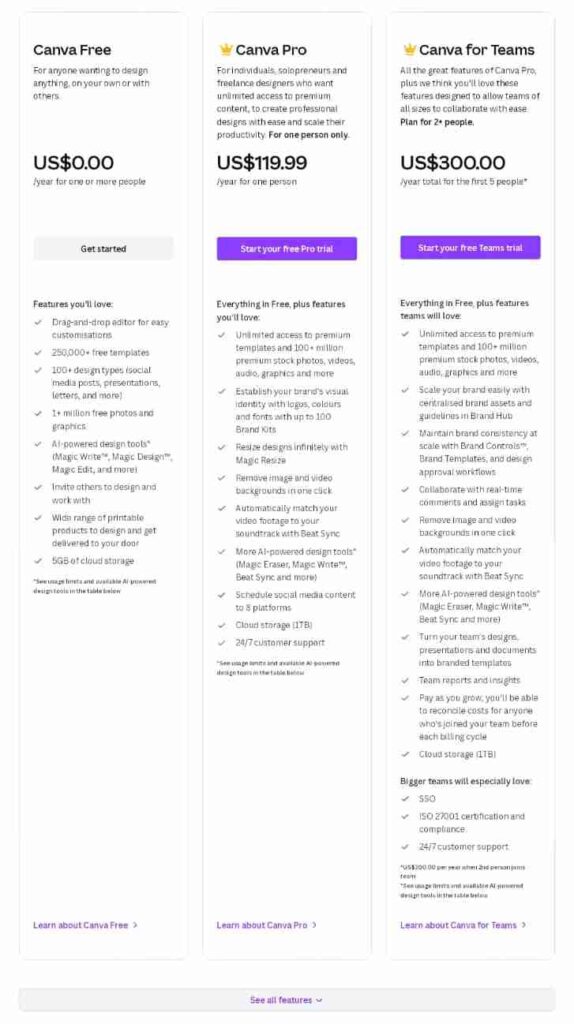
The freemium strategy works wonderfully in both customer acquisition and retention. It encourages ‘word of mouth’ referrals, helping Canva expand its user base. Many free users are also persuaded to switch to paid plans after testing out the product and seeing the benefits.
Another unique aspect of Canva’s freemium strategy is that it does not hide the premium features from its users on the platform. The brand lets its users try out some of these features (with restrictions). Some premium graphic elements, for instance, can be added to any design, but these elements have a Canva watermark, which can only be removed after the user upgrades to the paid account. This gives users a chance to see what they’re missing, luring them to upgrade to Pro plans.
A similar freemium model was seen in Airtable’s content marketing strategy, where they offered their users a free plan to explore their tool. Airtable also recommended them the best templates to use through blog posts, which helped in converting the free users to paying customers.
2. Canva Learn and Design School
When any visitor navigates to the Learn tab from the Canva homepage, they’re presented with the Canva Learn blog and another one called Design School. The Learn blog consists of useful resources for design enthusiasts, on photography, marketing, branding, and design. It also has useful resources for teachers, students, and nonprofits. The Design School, on the other hand, is an educational portal that gives users access to thousands of articles and tutorials on using different features of the tool.
Canva’s blog was launched way back in 2014 and was instantly successful with the people. Canva’s Growth Head at the time, Andrianes Pinantoan, has written about Canva’s blog growth strategy, explaining how they changed their strategy to grow blog traffic by 226.47%. Here is a brief overview of their blog strategy, as shared by Andrianes Pinantoan –
- Long-form blogs: Canva found that the most successful blog posts were the long-form ones, and started investing in more long-form content.
- Leveraging different blog writing formats: They diversified their blog writing format and made it a point to produce different types of content, like interviews, listicles, and feature articles. They also made sure the monitor the success of these blog posts to understand the preferences and needs of their audience.
- More inspirational blog posts: Inspirational-type blog posts were successful in getting more shares and signups. You can still see examples of these posts on their blog, like this one on How Wonderbly sold 3 million books worldwide with no publishing connections.
- Design newsletter: The Canva team also came up with a Design newsletter, which directed more traffic to the Design School blog and helped them get more subscribers.
- Tons of free resources: Free resources offered by Canva are popular with both new and existing users.
Canva understands the value of its blog, not only for driving traffic but also as a valuable educational resource and a tool for lead generation. Take a look at this Canva blog post on How design thinking is used to solve problems.

Canva blog post
It ticks all the boxes –
✅ Long-form
✅ Inspirational
✅ Educational
✅ Drives conversions/leads (with a pitch to Canva’s brainstorming tool)
What is most commendable is that Canva makes a genuine effort to guide and assist its users in making the most out of the tool. They come up with new and unique topics that could help people level up their design game. At the same time, they leverage product-led content marketing to effectively position their tool as the best solution for designing.
Another notable feature seen in both the Canva blogs is audience segmentation. The blogs are neatly categorized, which allows readers to easily navigate through the content and find what they are interested in.
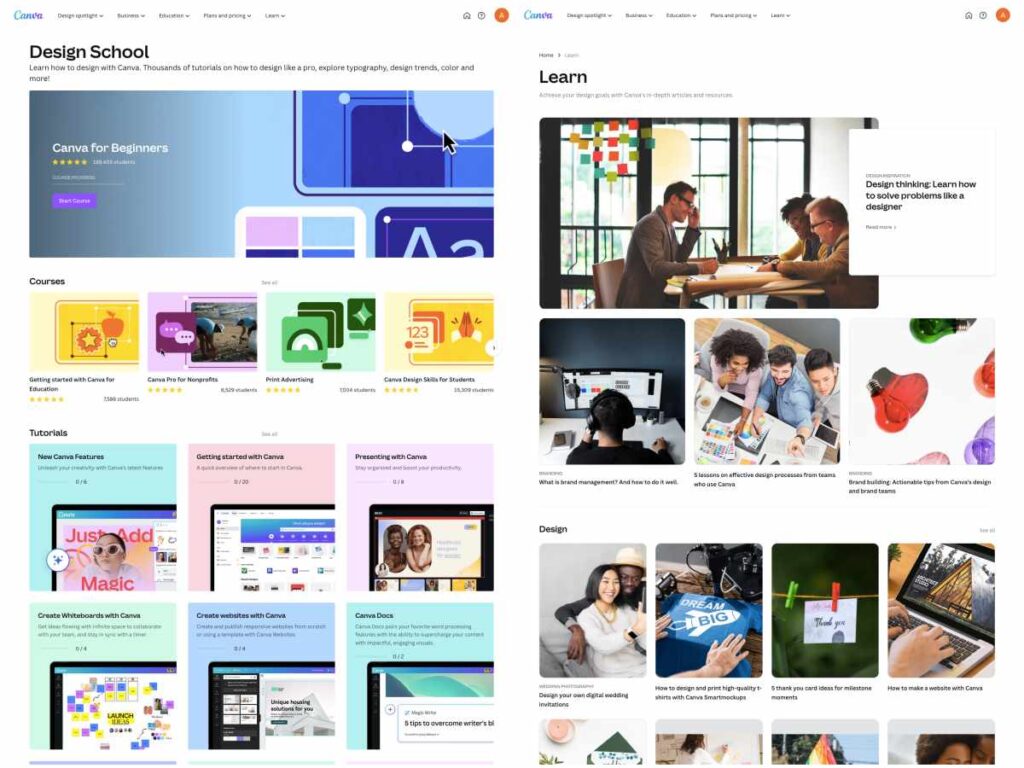
Canva Learn and Design School
We noticed something similar in our HubSpot content marketing case study, ClickUp case study, and the one on Monday’s content marketing strategy.
3. Canva’s content SEO strategy
If you’re looking to master content SEO, Canva’s SEO strategy holds some valuable lessons. Here’s a breakdown of their content SEO strategy –
a. Value-added content to maximize product experience
Relevant, valuable, and high-quality content that addresses the needs of the target audience is an important ranking factor for search engines. Canva understands this very well. They focus on providing value-added content that empowers users to improve their skills, while also inspiring them to explore the full potential of the tool. This content strategy does three things for Canva –
- Reduces obstacles for novice users on the platforms, and assists others in completing their creative tasks more effectively.
- Indicates to search engines that the site provides a positive user experience, which helps improve Canva’s search rankings.
- Strengthens the brand and builds Canva’s authority in the industry.
b. Solution-focused keyword strategy
Canva strategically selects keywords that would target their intended users and align with their goals and desired solutions. This is where we circle back to their ‘jobs-to-be-done’ marketing strategy, as the keywords are based on the specific tasks people can accomplish using the product. Canva focuses on identifying the objectives of their users and then directs them to a dedicated landing page that offers the specific solution they are seeking. For instance, when you search for “how to design a logo” on Google, you’ll find a Canva landing page among the top results.
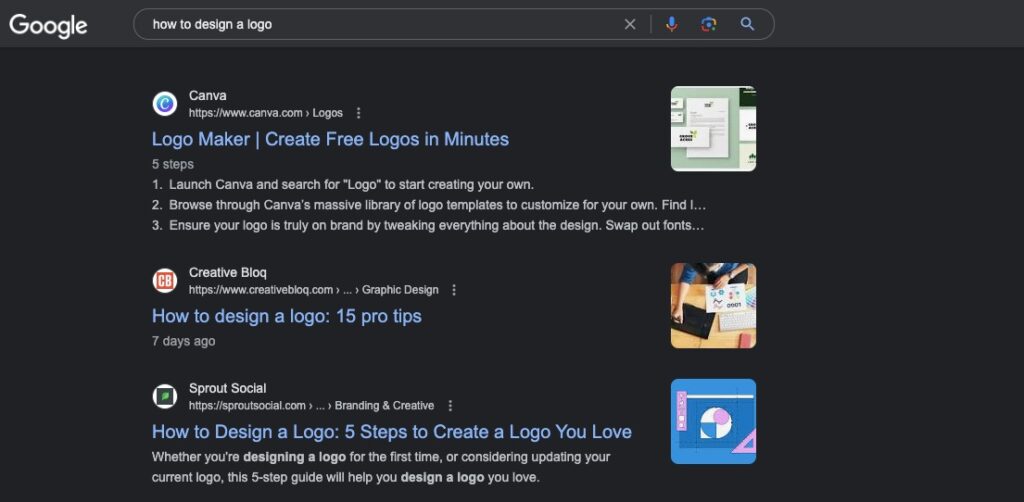
Canva in SERPs
This approach effectively positions Canva as a valuable tool that helps users accomplish their goals and also improves Canva’s conversion rates.
c. Building quality backlinks to improve domain authority
When you have a high number of websites linking back to your content, it can result in an improved search ranking and enhanced domain authority. But gaining backlinks requires a consistent, long-term investment, something which Canva has done beautifully. They have invested in specific, high-ranking landing pages to secure links from external sources. There’s also a team of outreach specialists at Canva who reach out to bloggers and content creators mentioning terms related to their product (like infographic templates, logo maker, etc.).
4. Canva on social media
Unlike many startups that heavily rely on paid advertising, Canva primarily banks on organic growth—by building social proof. Their gamble on this marketing approach has paid off, as Canva users have become active advertising engines for the product, spreading the word about the tool and sharing their designs on social. This marketing approach works as people are more interested in trying out a product when they see other people talking about it.
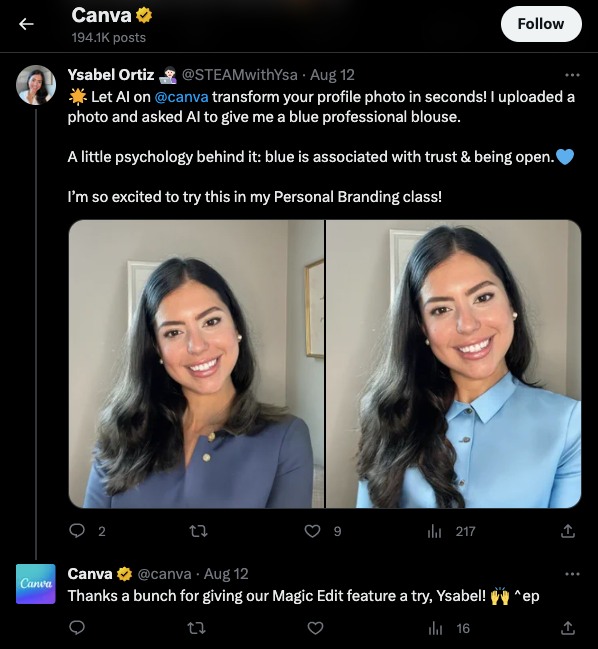
Canva user showing the Magic Edit feature in action
Canva also uses its social channels to deliver more value to its audiences, providing additional resources, tips, and tricks on designing. The brand does not create content for the sake of it; the carefully planned social media campaigns are based on strong concepts. And the content team tries out new and unique ways to communicate how easily everyone can design using Canva. They also make it a point to tailor their content strategy for the different social media platforms.
Canva on Facebook and Instagram
With over 2 million followers, Facebook is one of the biggest channels for Canva in terms of social media engagement. The content on this platform consists of a lot of images and short-form videos promoting the various use cases of their product, educating the users, and sharing news about upcoming events. The brand maintains an active presence on the platform by posting content consistently, and almost regularly.
Canva’s Instagram account is also quite successful, having over 1.5 million followers. The content on this platform is a lot like the one on Facebook, heavily focusing on fun and aesthetic visuals and reels to communicate with the audience. Canva also capitalizes on popular trends to introduce Canva to new users in a way that feels more natural. Beyond the usual educational and promotional content, they also post some community stories, where Canva showcases how different users benefited from using the product.

Community Story on Instagram
Canva’s YouTube channel
Canva’s YouTube channel has a different structure compared to its Facebook and Instagram pages. On those platforms, Canva shares a combination of informative, inspirational, and fun content. However, on YouTube, the focus is clearly on educating the audience. The brand tries to keep it as interesting and fun as the other channels, posting a combination of short-form videos (for YouTube Shorts) and long-form videos.
Canva’s YouTube channel almost feels like a video-based learning platform, offering a wide range of tutorials and design tips from experts. Canva makes it a point to provide valuable content to its audience without coming across as overly promotional. They have also organized their YouTube content into playlists, allowing viewers to quickly find what they need.
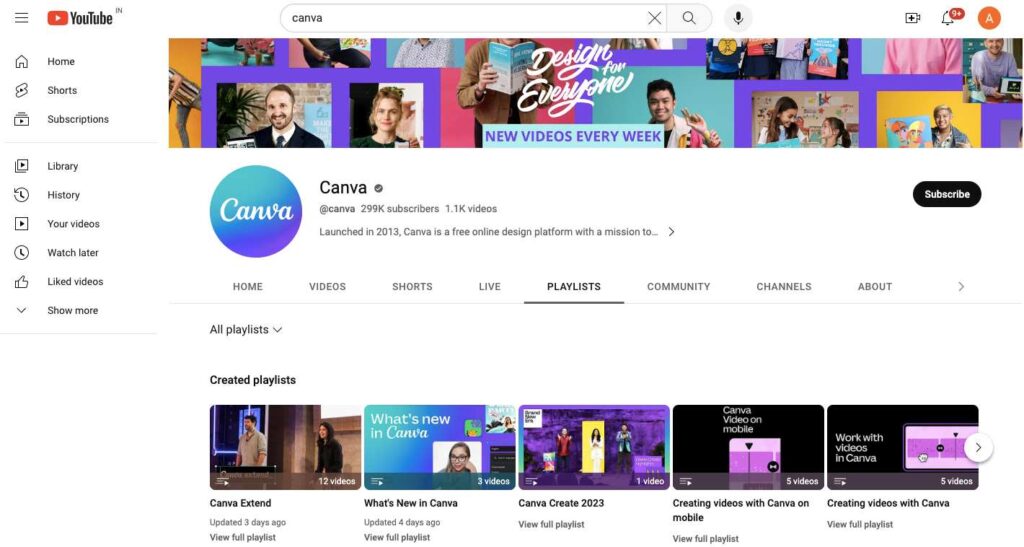
Canva YouTube playlists
Canva on Twitter
Canva uses this channel to engage its audience in a conversation. They post questions like –
- Describe the last thing you worked on in Canva in three words or less!
- Name your favorite Canva tool:
- How many designs do you think you’ve made in Canva?
The brand also uses Twitter to share memes, GIFs, and other relatable content with the audience.
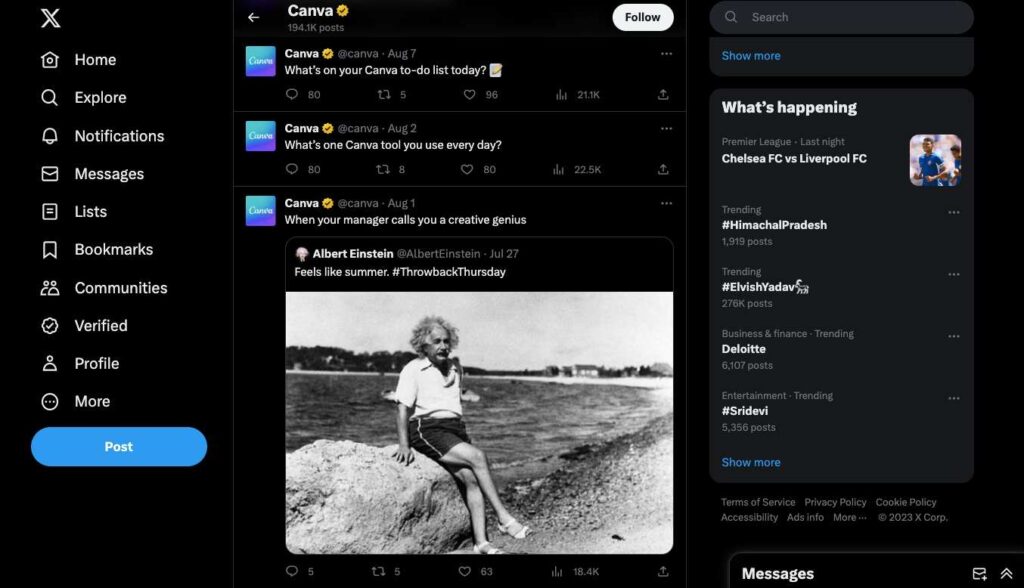
Canva on Twitter
We saw a similar strategy of connecting with the audience with relatable content in our case studies on Pearler’s content marketing strategy and Chime’s content marketing strategy.
5. Canva for Teams case studies
Canva strategically integrates case studies into its content marketing approach to showcase the tangible impact of its product and services on various businesses and individuals. By crafting compelling narratives that highlight real-world success stories, Canva effectively demonstrates how its design tools empower users to create stunning visuals and elevate their branding.
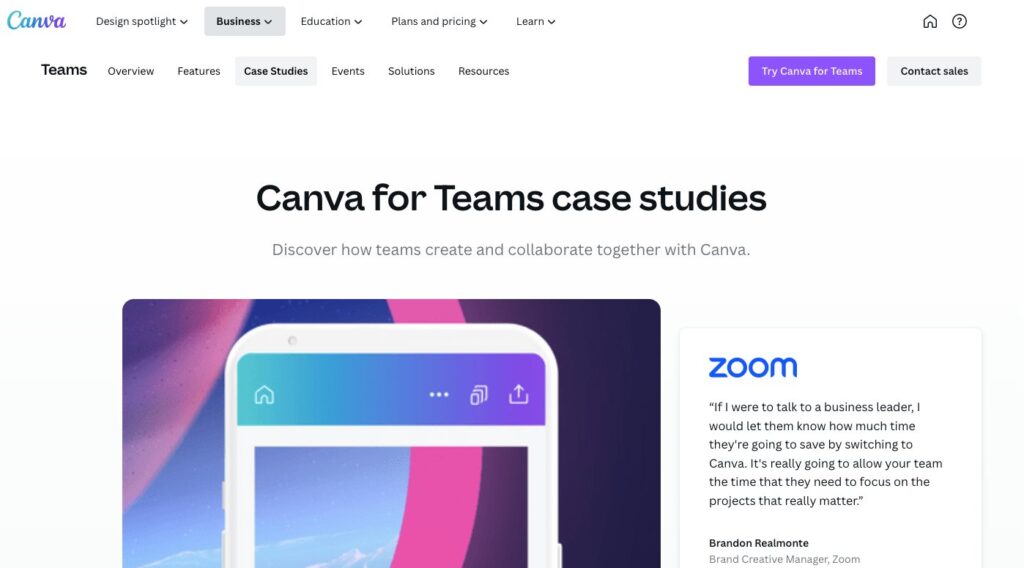
Canva for Teams case studies
These case studies not only provide insights into the creative process of organizations but also emphasize the versatility of Canva’s platform across diverse industries. There is also an option to filter the case studies by region and industry so that users can find relevant case studies for their niche.
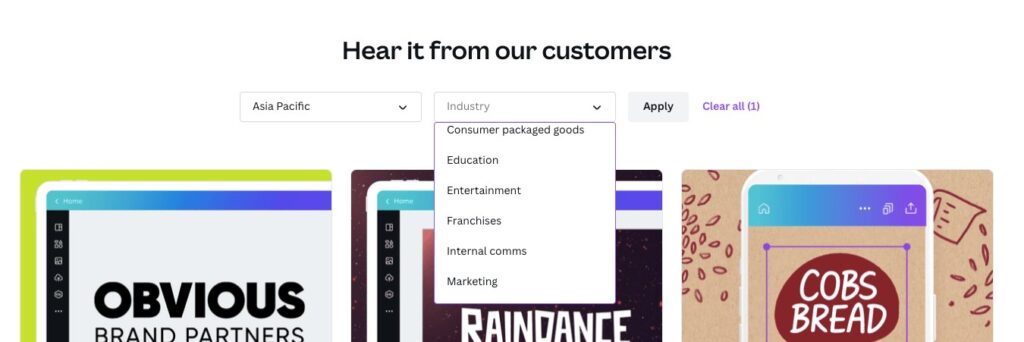
Canva Case Studies: Filters for region and industry
Canva makes it a point to back these case studies with data to show the tangible benefits of using the product. For instance, this case study on F45 showcases how this fitness brand improved its design efficiency with Canva’s help.

Canva F45 data-backed case study
6. Canva Creators and Affiliate Program
Canva has established a robust affiliate program that further extends its reach and engagement. By partnering with content creators who resonate with its design-centric ethos, Canva taps into a network of passionate advocates who promote the tool’s capabilities to their audiences. This helps Canva expand its user base and reinforce its brand presence in various online communities.
Besides the affiliate program, Canva also runs a Canva Creators program, which gives artists, illustrators, photographers, designers, and subject matter experts a chance to share their skills and knowledge on the platform. They also get to earn passive income in the process.
There are three options here for Canva creators –
- Template Creators (for graphic designers, desktop publishers, web designers, layout artists and art directors)
- Element Creators (for artists, illustrators, photographers, typographers, and videographers)
- Education Speciality Creators (for educational elements and resources on Canva)
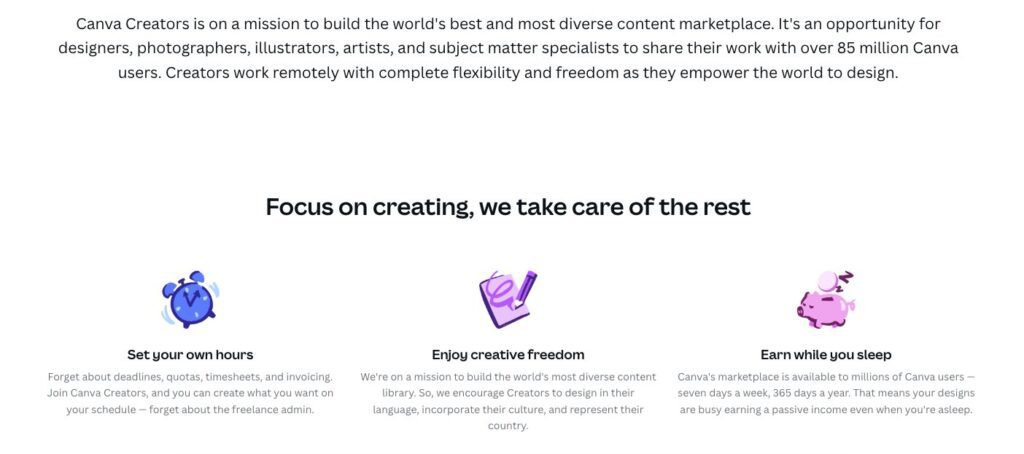
Canva Creators program
Partnering with the creator community and affiliates ties in with Canva’s user-centric philosophy. It is an excellent way to build a community around the brand. It also fosters knowledge sharing and a collective sense of belonging, further reinforcing Canva’s brand loyalty. If you’ve read our Etsy content marketing case study, the e-commerce brand also leveraged affiliate marketing for strategic product promotion.
What we learned from Canva marketing strategy
Canva’s ingenious approach to content marketing has carved out a niche for this brand in the saturated SaaS market. Diving into their marketing tactics, we’ve extracted a series of lessons for anyone aiming to bolster their own content marketing strategy –
- A balanced freemium model can be a catalyst for both acquiring new users and retaining existing ones. By offering substantial value in the free version, you set the stage for word-of-mouth marketing, while also teasing the additional benefits of the premium offerings.
- Craft content with SEO in mind. Understand your audience’s search intent and create targeted, solution-oriented content that resonates with their queries.
- Focus on providing value to your audience, whether through educational resources, actionable tips, or fun, relatable content. Value-added content is the best way to attract new audiences and retain your users.
- Investing in long-form content, such as in-depth articles or tutorials about your product, can really pay off. This content tends to perform well with audiences, driving more traffic and engagement.
- Experiment with different content formats, including interviews, listicles, and feature articles. Content diversification keeps your audience engaged and caters to different preferences.
- Real-world success stories, backed by hard data, can elevate the credibility of your product or service. Case studies offer prospective customers tangible proof of your product’s benefits leading to increased trust.
- Engage your audience in conversations on social media platforms by asking questions, sharing relatable content, and embracing current trends. Make sure you tailor your content to each platform’s audience and keep engagement authentic.
- Affiliates, especially those who are industry experts or influencers, lend credibility to your brand. Their endorsement acts as a vote of confidence for your products, making potential customers more likely to trust your offerings.
Win at SaaS content marketing with Narrato AI
So, there you have it – the Canva marketing strategy decoded. A finely tuned orchestration of content creation, SEO, and community building. As brands and marketers navigate the content space, Canva’s experiences offer a roadmap of adaptable strategies. Their content marketing strategy offers invaluable lessons for businesses looking to grow and enhance their brand reach. But let’s not forget that replicating such success requires the right tools and resources. That is where Narrato AI comes in. This AI content workspace can help you streamline your content creation process from start to finish. With AI tools like AI writer, AI SEO content brief generator, AI image generator, and AI Chat Engine, you can boost your content marketing productivity by 2x and scale up your content creation efforts. The content workspace also offers several other tools for content planning, collaboration, and publishing, besides project and team management.
If you’re interested in learning how Narrato helped Park+ scale content creation by 6x and save 200 resource hours, check out this case study. Another SaaS platform using Narrato for managing its content marketing efforts more efficiently is Rocketlane. You can learn more about their content strategy in this content marketing case study on Rocketlane.
Emulate Canva’s strategic content marketing approach and unlock the potential of your content with Narrato AI. Get started today!





